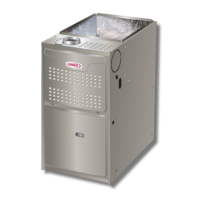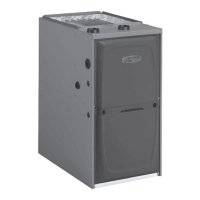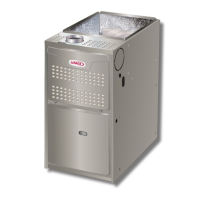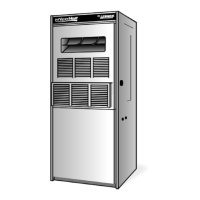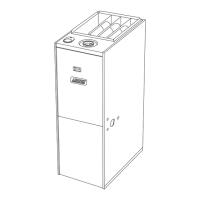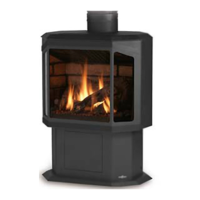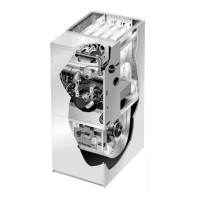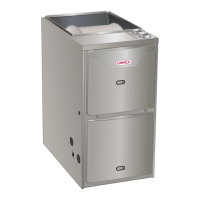0650329-56 / 506265-03Issue 1924Page 4 of 13
Condensate Drain Connection
Do not operate unit without a drain trap. The condensate
drain is on the negative pressure side of the blower;
therefore, air being pulled through the condensate line
will prevent positive drainage without a proper trap.
To avoid drain pan overow, the web must be removed
from inside any threaded drain pan hole to which a
drain line is to be connected. Use care when removing
the web so as to not damage the coil.
On horizontal units, the primary drain connection is ush
with the bottom of the inside of pan. Auxiliary connection
is raised above the bottom of the inside of the pan. Plastic
web covering 3/4” auxiliary connection must be broken
out if used. Do not get primary and auxiliary connections
interchanged.
When making drain tting connections to the drain pan,
hand tighten only. Overtightening the ttings can split
connections on the drain pan.
The unit is provided with 3/4” FPT condensate drain
connections.
• Connect the drain lines to the appropriate drain pan
ttings.
• Secondary drain connections should be connected to
a separate drainage system.
• Install a trap in the drain line below the bottom of the
drain pan and pitch the drain lines down from the coil at
least 1/4” per foot of run. Horizontal runs over 15’ long
must also have an anti-siphon air vent (stand pipe),
installed ahead of the horizontal run. An extremely
long horizontal run may require an oversized drain line
to eliminate air trapping.
• Route to the outside or to an appropriate drain. Check
local codes before connecting drain line to an existing
drainage system.
• Insulate drain lines where sweating could cause water
damage.
• The removal of cabinet knockouts required for drain
connections can be made much easier with the indoor
coil assembly removed from the cabinet.
• Install drain lines so they do not block service access
to front of unit. A 24” clearance is required for lter,
coil, or blower removal and service access.
• Make sure unit is level or pitched slightly toward
primary drain connection so that drain pan will empty
completely without water standing in pan.
• Install a 2” trap in the primary drain line as close to the
unit as practical. Make sure that the top of the trap is
below connection to the drain pan to allow complete
drainage of pan.
• Auxiliary drain (if used) should be run to a place
where it would be noticeable if it becomes operational.
Occupant should be warned that a problem exists if
water should begin running from the auxiliary drain
line.
• Test condensate drain pan and drain line after
installation is complete. Pour several quarts of water
into drain pan, enough to ll drain trap and line. Check
to make sure drain pan is draining completely, no leaks
are found in drain line ttings, and water is draining
from the termination of the primary drain line.
Unit
DrainConnection
Positive Liquid Seal Required
3.00" Min.
1.00" Min.
12.00"
Max.
Figure 1. Typical Condensate Drain Connection
A eld fabricated auxiliary drain pan, with a drain pipe to
the outside of the building, is required in all installations
over a nished living space or in any area that may be
damaged by overow from the main drain pan. In some
localities, local codes may require an auxiliary drain pan
for any horizontal installation.
CAUTION

